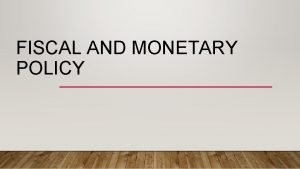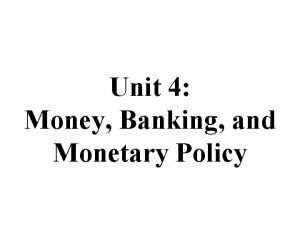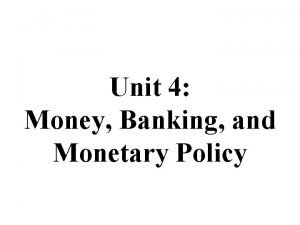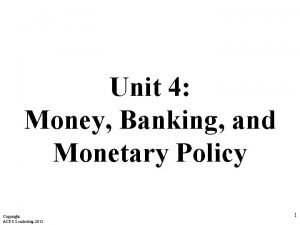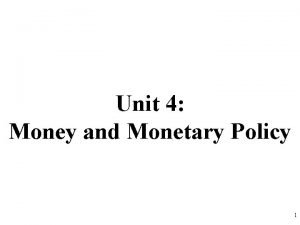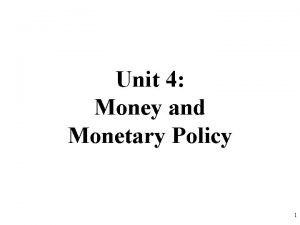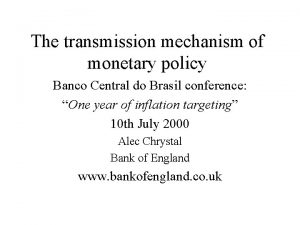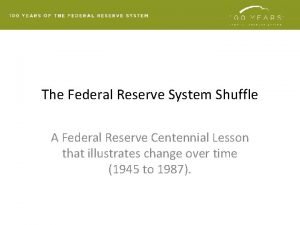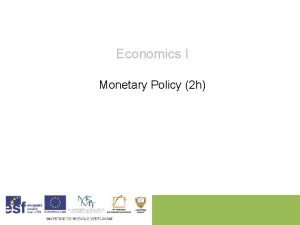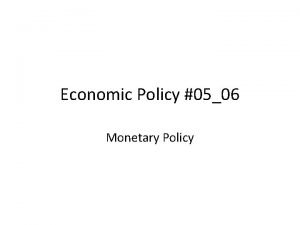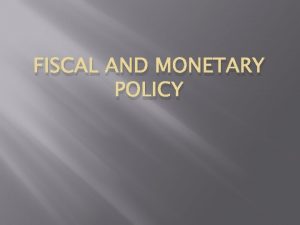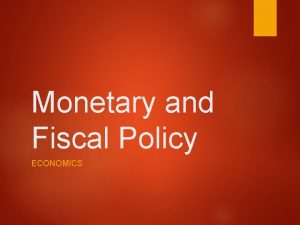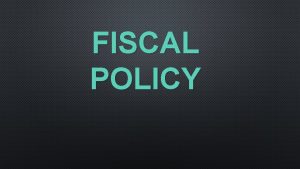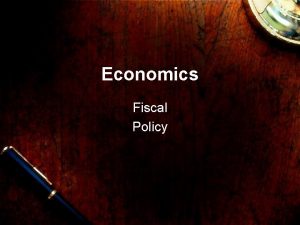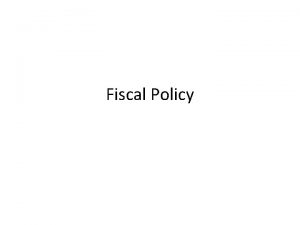Fiscal Monetary Policy Unit 4 Section 3 Fiscal

















- Slides: 17

Fiscal & Monetary Policy Unit 4, Section 3

Fiscal Policy Government policy which seeks to counter fluctuations in the business cycle.

How can the government impact the economy through fiscal policy? • Changes in purchases • Transfer payments • Unemployment benefits • Social security • Welfare • Tax changes • Increases in taxes less disposable income • Decrease in taxes more disposable income Fiscal Policy

Fiscal Policy Expansionary Policy Contractionary Policy If the economy is in a recession, the government seeks to return the economy to Fe or Ye. • AD must shift to the right If the economy is in an expansionary period, the government seeks to return the economy to Fe or Ye. • AD must shift to the left • INCREASE Gex • INCREASE transfer payments more C • DECREASE taxes more C • DECREASE Gex • DECREASE transfer payments less C • INCREASE taxes less C • Pawnee Government Shut Down

• Recall that government actions are MULTIPLIED • Government Spending Multiplier 1/MPS OR 1/1 -MPC • THE GREATEST IMPACT due to direct injections in the circular flow • Tax Multiplier - MPC/MPS OR 1 less than the spending multiplier and NEGATIVE • Transfer Payment Multiplier MPC/MPS, or 1 less than the spending multiplier *note MPC is postive Fiscal Policy

Balanced Budget Multiplier • The combined effects of government spending and taxes on national income • Balanced budget means change in government expenditure is exactly matched by a change in taxes.

Types of Fiscal Policy Stabilizers Automatic • This matches up automatically with the business cycle • Policies or payments already in effect shift to counter the economic cycle • Usually, transfer payments and taxes will be amongst the most common • If we were in a recession, more people would become UE • More people would draw UE benefits • Less taxes are collected from these people • If we were in an expansionary period, fewer people would be UE • Less people would draw UE benefits • More taxes are collected as people see increases in employment and maybe even wages. Discretionary • This is an action specifically taken and sought out by the government. • A specific problem is identified and then a policy is passed to counter the problem. • 2008 Recession Obama Stimulus Package

• We can assess the impact of policy with an Aggregate Expenditure Graph • Y Axis : Aggregate Expenditures • Notice each line is indicating a different facet of Expenditures or AD • X Axis : GDPr • 45 Degree Line : This represents equilibrium in the Keynesian Theory Impacts of Fiscal Policy

• In the previous graph, we saw examples of AE models. • If there were an increase in Gex, what would happen to the GDPr? • What would then be the impact on a the need for money? Impacts of Fiscal Policy

Monetary Policy The Federal Reserve’s use of money and credit controls to influence interest rates, inflation, exchange rates, and GDPr.

How can the Fed impact the economy through monetary policy? • Adjust the required reserve ratio • Adjust the discount rate banks pay • Open Market Operations • BONDS!!!!!! Monetary Policy

Monetary Policy Expansionary Policy Recessionary Policy • If the economy is in a recession, the Fed seeks to return the economy to Fe or Ye. • If the economy is in an expansionary period, the Fed seeks to return the economy to Fe or Ye. • Policies that INCREASE MS • Decreases Interest Rate • Drives up AD Schrute Bucks & Creed • Policies that DECREASE MS • Increase Interest Rate • Drives AD down

Consider Impacts on Money Market, Loanable Funds, and AD/AS! Monetary Policy Graphs

• The Money Multiplier

• The interest Rate charged by commercial banks to loan money between one another. • Although this is not a direct action of the FED, money supply can impact this rate. • If the Fed increases the MS, banks will have more money • The supply of loanable funds increases, pushing down the FFR • We should also consider the way loans from the FED are perceived, the FED should be the “Lender of Last Resort” • I. E. it looks better to borrow from another bank! The Federal Funds Rate

Mixing Fiscal & Monetary Policy Usually the Fed and Government will both implement policies to have the greatest impact. There are different theories on the role and importance of each policy.

Monetarists Classical Supply - Side Keynesians • Money Supply is most • The economy • Changes in taxes will also • Demand is most important adjusts ITSELF impact supply • Government intervention can • “monetary rule” where MS • The government • Less tax means businesses fix AD increases at the same rate shouldn’t interfere can invest more • Believe MS changes are less of Y • Encourages LR growth effective than Fiscal Policy • Fiscal Policy should not be used often (if ever) • Believe that the D for money is very sensitive and steep • Believe that the D for I is relatively flat • Laffer Curve – tax cuts could • Believe the D for money is result in increases tax revenues relatively flat • Believe the D for I is relatively steep and resistant to change • Liquidity Trap: changes in the money supply will have no effect on interest rates Views of Intervention
 Unit 5 macroeconomics lesson 2 activity 45 answer key
Unit 5 macroeconomics lesson 2 activity 45 answer key Fiscal vs monetary policy
Fiscal vs monetary policy Unit 4 money banking and monetary policy
Unit 4 money banking and monetary policy Unit 4 money banking and monetary policy
Unit 4 money banking and monetary policy Unit 4 money and monetary policy
Unit 4 money and monetary policy Unit 4 money and monetary policy
Unit 4 money and monetary policy Unit 4 money and monetary policy
Unit 4 money and monetary policy Unit 3 aggregate demand and aggregate supply
Unit 3 aggregate demand and aggregate supply Tax multiplier formula
Tax multiplier formula Unit 3 aggregate demand aggregate supply and fiscal policy
Unit 3 aggregate demand aggregate supply and fiscal policy Transmission of monetary policy
Transmission of monetary policy Lesson quiz 16-1 monetary policy
Lesson quiz 16-1 monetary policy What are the objectives of monetary policy
What are the objectives of monetary policy What is the meaning of monetary policy
What is the meaning of monetary policy To type
To type What are the objectives of monetary policy
What are the objectives of monetary policy Objectives of monetary policy
Objectives of monetary policy Contractionary fiscal policy interest rate
Contractionary fiscal policy interest rate

